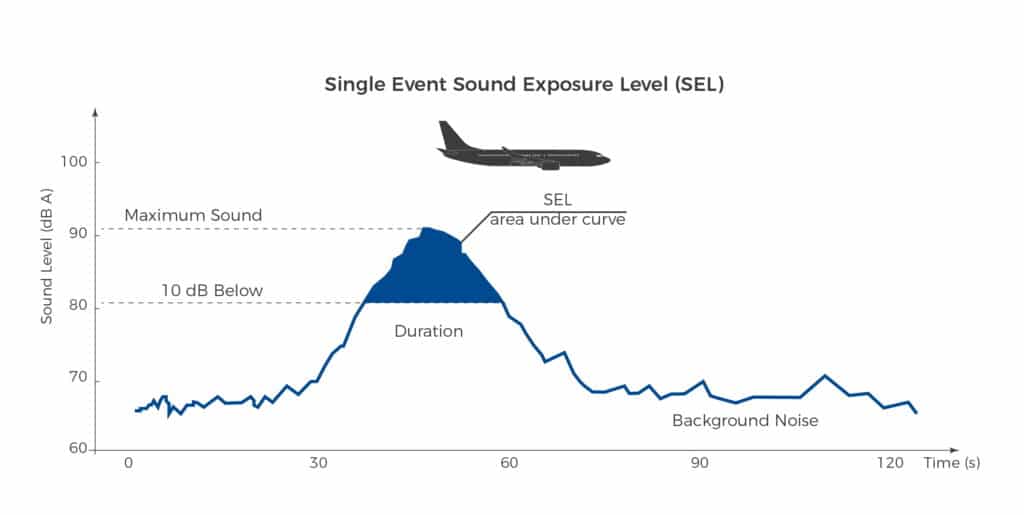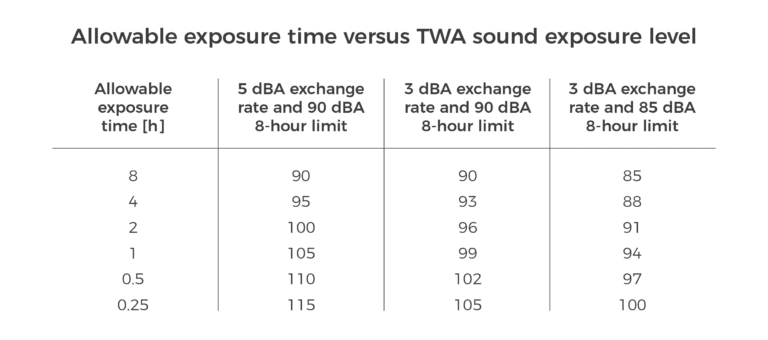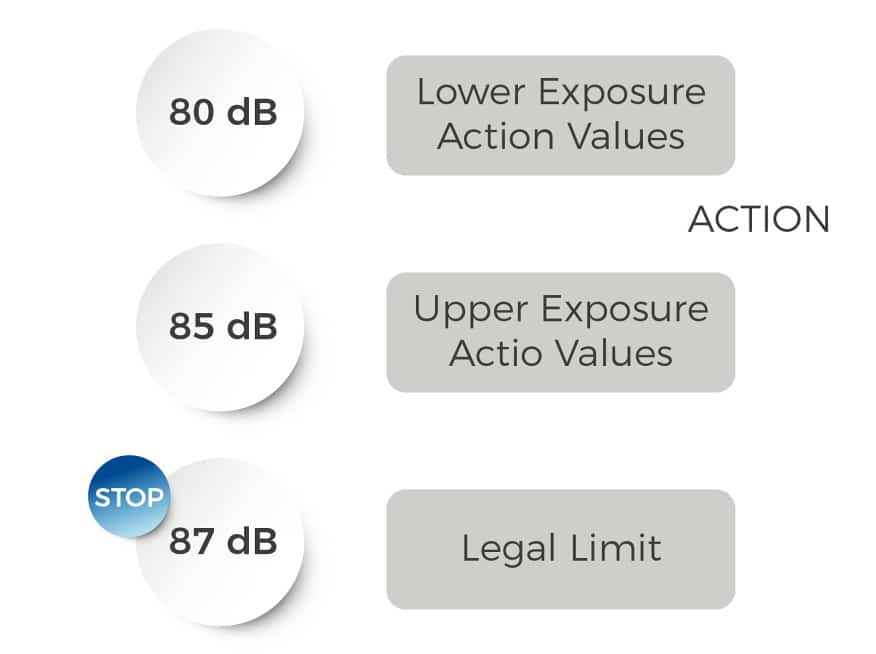Sound Exposure Level
Sound Exposure Level (SEL) is an acoustic parameter for measuring the total energy of a sound event, allowing for standardized comparison of noise events and assessment of their impact on the environment and human health.
Sound Exposure Level (SEL) is an acoustic parameter for measuring the total energy of a sound event, allowing for standardized comparison of noise events and assessment of their impact on the environment and human health.
Sound exposure, according to IEC 61672-1:2013, is defined as the time integral of the square of a frequency-weighted sound-pressure signal over a stated time interval or event of stated duration. It is quantified as:

where p(t) is the square of the A-weighted sound-pressure signal during the integration time T starting at t1 and ending at t2.

Sound Exposure Level (SEL), denoted as LAE, is an acoustic parameter used to measure the total energy of a sound event as if it happened in one second. This makes it possible to compare noise events of different lengths of time in a standard way. It is calculated by integrating the square of the A-weighted sound pressure over the event’s duration and then converting it to a logarithmic scale relative to a reference pressure.
To explain the math, SEL takes the A-weighted sound pressure levels, squares them to get the sound power, adds up this power over the whole event to take into account the energy, and then uses a reference pressure to scale the result logarithmically. This process yields a decibel value that reflects the cumulative sound energy, making it easier to compare one sound event to another or to evaluate its potential impact against noise regulations or health standards.
Sound exposure level (SEL) is a logarithmic measure of the sound exposure relative to a reference value squared over a standardized time interval, which allows comparison of different events or intervals. It is expressed in decibels (dB) and calculated using the formula:


The Sound Exposure Level (SEL) is primarily used to assess noise events such as traffic, rail, and aircraft operations rather than workplace noise. SEL is valuable in environmental noise monitoring application and for regulatory compliance in transportation systems to measure the impact of noise events on communities and to guide noise abatement procedures.
For example, in airport noise monitoring, SEL is used to quantify the noise impact of aircraft takeoffs and landings on surrounding areas. Similarly, in urban planning, SEL measurements help in evaluating the effects of road or rail traffic noise on residents and in the development of noise barriers or other mitigation strategies. These applications are essential for maintaining environmental quality and for the health and well-being of communities affected by such noise events.a

SEL simplifies the comparison of acoustic events by normalizing them to a standard time duration of one second, regardless of the actual event’s length. This normalization allows for a direct comparison of the energy content of different noise events. A-weighting adjusts the frequency content of the sound to match the human ear’s sensitivity, making the LAE a more accurate representation of the perceived impact of sound on humans. By measuring the total acoustic energy in this manner, SEL provides a valuable tool for noise analysis, especially in environments where intermittent and fluctuating noise levels are present.

Understanding sound pressure, sound exposure, sound power, and sound intensity is key to comprehending various aspects of sound and its impact on the environment and health.
Sound pressure is the effect of a sound wave that causes a fluctuation in the ambient pressure of a medium like air. It is what the human ear detects and is measured in pascals (Pa). Sound pressure is most commonly measured in the field of audio and acoustics to assess the loudness of environments, from concert halls to industrial workplaces. It’s used to ensure sound levels are within comfortable and legal limits, to design soundproofing in buildings, and to develop high-quality audio equipment.
Sound power is a source-specific quantity describing the total sound energy emitted by a source per unit time, irrespective of its environment, and is measured in watts (W). Sound intensity describes the flow of sound energy through a unit area in a specific direction, essentially the rate at which sound energy is transmitted, measured in watts per square meter (W/m²). Sound power is used in the manufacturing of machinery and consumer products to characterize and compare the noise levels of different equipment. It aids in designing quieter machines and in the enforcement of noise regulation by providing a standardized way to document the inherent loudness of a source.
Sound intensity considers the energy transfer in a particular direction and through a specific area, providing information about how sound energy propagates through a medium. It describes how much sound power passes through a unit area (usually one square meter) in a specific direction, and is thus a vector quantity with both magnitude and direction. It is measured in watts per square meter (W/m²). It’s used in architectural acoustics for optimizing room designs and in the automotive industry for identifying and minimizing unwanted noise in vehicle cabins.
Sound is a vibrational wave that travels through mediums such as air, water, or solids, and is perceived by the auditory system. It is generated by vibrating objects and is characterized by properties such as frequency, amplitude, and wavelength.
As sound waves travel, they cause particles in the medium to oscillate, creating regions of higher and lower pressure. The frequency of these waves, or the number of pressure cycles per second, is measured in hertz (Hz), while amplitude, or the size of the pressure variations, correlates with volume and is measured in decibels (dB). These properties form the basis of acoustic measurements, including sound exposure levels.
Sound perception is the process by which the human auditory system interprets and makes sense of sound, and it plays a crucial role in the context of sound exposure levels (SEL). It involves the reception of sound waves by the ear and the brain’s interpretation of these waves as distinct auditory experiences.
The SEL is an important metric in understanding how sound is perceived over time. It represents the cumulative energy of a sound event, considering both the intensity and duration of exposure. Since human hearing can be affected by prolonged exposure to high levels of sound, even if not extremely loud, SEL provides a way to quantify potential impacts on hearing health. It integrates all the energy of the sound reaching the ear over a particular time, offering a more comprehensive measure for assessing potential damage or disturbance caused by noise exposure.
Sound exposure refers to the overall acoustic energy received by a listener over time, while noise exposure specifically focuses on unwanted or potentially harmful sound levels that could lead to health effects, particularly in occupational settings.
In detail, sound exposure is a broad term that encompasses all types of sound, including both noise and desired sounds, and can be applied to various fields such as acoustics, environmental monitoring, and audiology. Noise exposure, however, is more frequently used in contexts where sound may have negative implications, such as in the assessment of risks to hearing health in workplaces. Accurate measurement of noise exposure is essential for implementing protective strategies and ensuring compliance with safety regulations that aim to prevent noise-induced hearing loss and other health issues related to excessive sound levels.
The Personal Sound Exposure Level (PSEL) is a key metric used to assess an individual’s potential risk of hearing damage due to noise in the workplace. It is an adaptation of the equivalent continuous sound level (LAeq) over a standard eight-hour workday, designed to reflect cumulative exposure rather than instantaneous noise levels. In the calculation of PSEL, the actual noise exposure time (T) is taken into consideration alongside a reference duration of eight hours (T0 = 28,800 seconds). The logarithmic component in the formula accounts for the varying exposure times by scaling the continuous noise level to an eight-hour period. This means if an individual is exposed to noise for less than eight hours, the actual exposure level will be increased in the PSEL calculation to reflect what it would have been over an eight-hour day.
The 8-hour sound exposure level, denoted as LEpd, is a parameter used in occupational noise regulations (for example in the UK) for assessing the noise exposure of workers over a standard workday. LEpd aims to ensure that the noise levels workers are exposed to do not exceed safe limits, reducing the risk of noise-induced hearing loss.
Level Exposure LEX,8h refers to the equivalent continuous A-weighted sound pressure level measured over an 8-hour workday. It is a time-weighted average that quantifies the total noise exposure, accommodating varying noise levels throughout the workday. This metric is crucial for assessing occupational noise exposure and determining compliance with safety regulations aimed at preventing noise-induced hearing loss. It incorporates all noise a worker is exposed to, including continuous, intermittent, and impulsive noises, providing a comprehensive measure of noise exposure risk.
Noise Dose in % is the noise dose received by an employee, expressed as a percentage of the entire allowable daily noise dose. For example, a full permissible dose equivalent to 85 dB(A) over an 8-hour period is 100%.
Leq equivalent continuous sound level is an acoustic parameter that describes the average energy of the sound pressure level over a certain measurement time. Therefore, it is a continuous and steady noise level that has the same acoustic energy as a fluctuating, variable noise level measured over the same period.
LAV, similar to LEQ, is the average sound pressure level for a given measurement time. In fact, the Leq and Lav are the same when the value of the exchange rate is 3. The term Lav is used when an exchange rate value is different from 3 dB. Different exchange rates are used to assess the impact of noise under various regulations or in different countries.
Time-weighted average (TWA) is an acoustic parameter to average varying exposure levels over the duration of exposure. In the context of noise and considering an 85-dBA exposure limit and a 3-dB exchange rate, the TWA is calculated with the formula:
TWA = 10.0 x Log(D/100) + 85
The TWA formula provided is used to assess occupational noise exposure, taking into account variations in noise levels over time and normalizing these variations into a single average value for comparison against exposure limits.

The exchange rate is a factor that determines how much the exposure duration should be reduced for every increase in noise level. For example, with an exchange rate of 3 dB, every increase of 3 dB means the permissible exposure time should be halved to maintain the same level of risk or exposure.
In the EU and many other countries using Leq as the main indicator, the exchange rate is 3. In some countries (like the United States and parts of Canada), it is different and equals 5. When the exchange rate is 5, then instead of Leq, Lav is used.
This 5-dB exchange rate allows for longer exposure to continuous noise at higher levels compared to the 3-dB rule, presuming that some hearing recovery occurs during interruptions in noise exposure. Despite initially recommending the 5-dB exchange rate based on limited data from the early 1970s, NIOSH has revised its recommendation to the 3-dB exchange rate after reviewing more recent scientific evidence. The evolution of the 5-dB exchange rate started with the Committee on Hearing, Bioacoustics, and Biomechanics (CHABA) in 1965, which aimed to assess allowable exposures to different types of noise, leading to the establishment of criteria based on temporary threshold shift experimentation.
The daily noise exposure level, denoted as LEX,8h, represents the time-weighted average of noise exposure over a standard eight-hour workday. This measurement incorporates all types of workplace noise a person is exposed to, including continuous, intermittent, and impulsive noise. The standard is referenced against a baseline sound pressure of 20 micropascals (µPa), which is the generally accepted threshold of human hearing.
The weekly noise exposure level, also represented as LEX,8h but often specified for the weekly duration, is the average of daily exposure levels across a typical working week of five eight-hour days. This concept extends the time-weighted average to account for cumulative exposure throughout the week.
Both measures follow the guidelines of ISO 1999:1990, which provides a methodology for determining potential noise-induced hearing impairment in the context of noise at work. The standards help in assessing occupational noise exposure and forming the basis for protective measures to prevent hearing loss due to workplace noise.
The acceptable noise exposure level in various international guidelines and regulations is generally centered around 85 dB(A) for an 8-hour time-weighted average (TWA), with a peak limit of 140 dB(C) to prevent immediate hearing damage. These standards are established to minimize the risk of hearing loss and auditory injury over a worker’s career.
Across different organizations, such as the EU Noise Directive, NIOSH, I-INCE, ACGIH, and OSHA, the exposure limit values and action values aim to protect workers from the adverse effects of noise. The EU Noise Directive sets the strictest maximum at an 8-hour LEX of 87dB(A), with action values at 85 and 80 dB(A) for daily exposure. NIOSH and ACGIH both recommend an 85 dB(A) limit over an 8-hour TWA, indicating a significant risk of hearing impairment at or above this level over extended periods. OSHA allows a higher threshold for continuous exposure at 90 dB(A) for an 8-hour TWA but requires action at 85 dB(A). The consensus on the peak sound pressure level remains consistent at 140 dB(C) across these guidelines to prevent acute harm from sudden loud noises. Despite slight variations, these values reflect a global understanding of the importance of managing noise exposure to safeguard hearing health.
The levels set by EU Noise Directive 2003/10/EC for daily and peak noise exposures are specified as follows:

The National Institute for Occupational Safety and Health (NIOSH) suggests an exposure limit for occupational noise. The REL is set at 85 decibels, A-weighted, over an 8-hour time-weighted average (85 dBA as an 8-hour TWA). Exposures at or above this level are considered hazardous.
The NIOSH identified that there’s an approximately 19% risk of hearing impairment for workers exposed to 85 dB(A) over a 30-year period. This is based on a comprehensive review of data, including the 1972 criteria for occupational exposure to noise.
Employers are required to assess noise exposure when a worker’s 8-hour Time-Weighted Average (TWA) noise exposure reaches or surpasses 85 dBA, in accordance with the American National Standard Measurement of Occupational Noise Exposure, ANSI S12.19-1996. This assessment must be carried out without considering the effect of hearing protection devices.
The International Institute of Noise Control Engineering (I-INCE) recommends an upper limit for occupational noise exposure of 85 dB(A) for an 8-hour workshift to minimize the risk of hearing impairment. Additionally, it advises a peak sound pressure level of 140 dB(C) to prevent immediate hearing damage from sudden, intense noises.
The American Conference of Government Industrial Hygienists (ACGIH) recommends that worker exposure to noise should not exceed 85 decibels, A-weighted (dBA), over an eight-hour workday to prevent hearing loss. This limit is based on an exchange rate of 3 dB, which means that for every 3 dB increase in noise level, the permissible exposure duration is halved. The OELs focus on noise levels across critical speech frequencies of 500, 1000, 2000, and 3000 Hz, aiming to limit noise-induced hearing loss to 2 dB(A) over 40 years. For noise exposure evaluations, the ACGIH specifies using instruments conforming to IEC standards, set to the A-weighted scale.
OSHA has established occupational noise exposure limits to minimize the risk of hearing loss and other adverse effects from excessive workplace noise, as outlined in the OSHA Regulations 29 CFR 1910.95. OSHA’s permissible noise exposure limit for continuous noise over an 8-hour period is TWA of 90 decibels on the A-weighted scale (dBA). Additionally, the action level at which employers must implement a hearing conservation program is an 8-hour TWA of 85 dBA. The 115 dBA SPL and 140 dBA are limit levels for short duration impulse noise.

Noise exposure assessment is the process of measuring or estimating the intensity and duration of noise that individuals are exposed to in order to evaluate the potential for hearing damage or other health effects. This process often involves the use of sound level meters, dosimeters, and frequency analyzers to gather accurate readings of the noise environment, and it is a critical step in implementing effective noise control and hearing conservation programs.
The assessment typically quantifies the noise levels in terms of decibels (dB), with an A-weighting (dBA) applied to reflect the human ear’s response to different frequencies. Time-weighted averages (TWA) are calculated to determine the average exposure over a work shift, considering the varying levels of noise and exposure times. The collected data enables employers and safety officials to compare the measured noise levels against regulatory limits and guidelines to decide whether protective measures, such as the use of hearing protection devices, changes in work practices, or engineering controls, are required. The goal of noise exposure assessment is to identify risky exposure levels, prevent hearing loss, and ensure a safe and healthy work environment.
A Leq Sound Level Meter is a type of integrating sound measuring instrument designed to measure the average sound pressure level over a specified period of time. Leq sound level meters are used to assess the potential harm of noise to human hearing, especially in occupational and environmental noise assessments, among other applications. A professional Leq sound level has features like frequency weighting (e.g., A-weighting or C-weighting) and selectable Leq integration interval (e.g 1 minute or 1 hour).
A noise dosimeter is the preferred device for measuring a worker’s noise exposure in situations where noise levels are not consistent, containing impulsive components, or when the worker is not stationary but moves frequently during the work shift. This contrasts with the use of a sound level meter, which is easier to use for continuous noise levels when the worker remains in one place.
